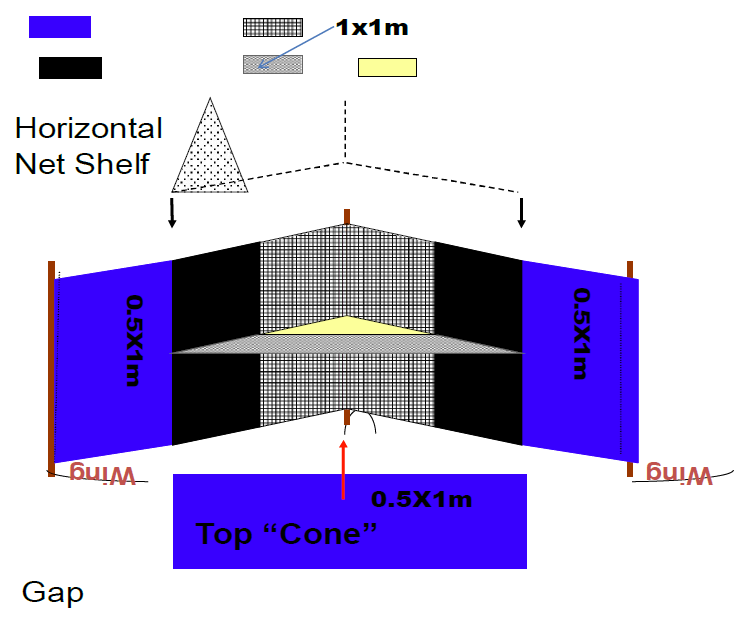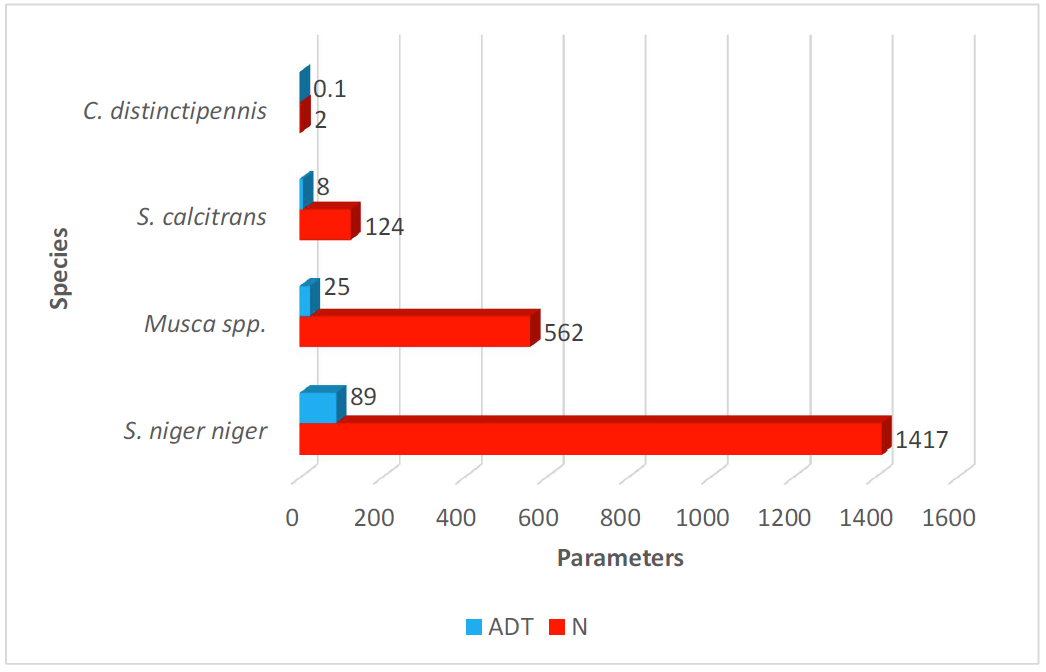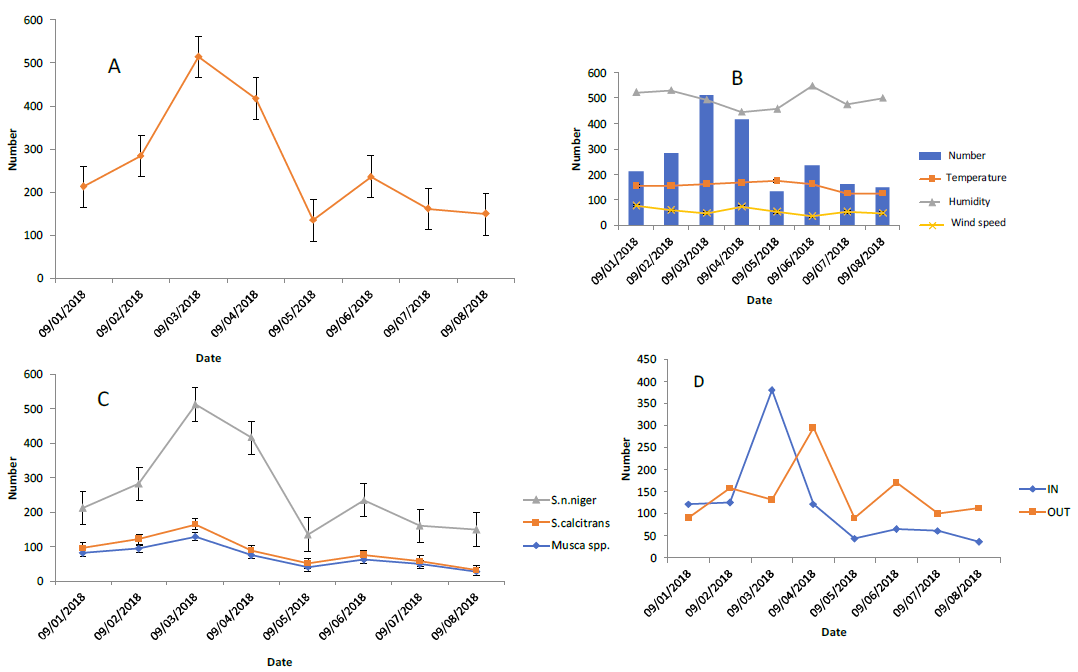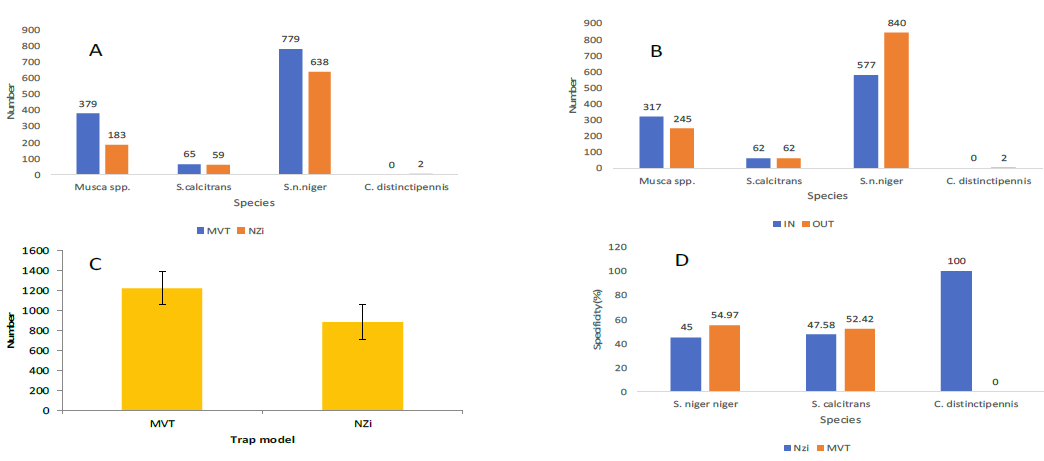Comparative Efficacy of Unbaited Modified Vavoua and Nzi Traps in the Capture of S. niger niger M. 1851 and S. calcitrans L. 1758 in Ngaoundere-Cameroon
Article Information
Sevidzem Silas Lendzele1*, Zinga Koumba Christophe Roland2, Acapovi-Yao Genevieve Lydie3, M’batchi Bertrand4, Jacques François Mavoungou2,4
1Ecole Doctorale des Grandes Ecoles (EDGE), Laboratoire d’Ecologie Vectorielle (LEV-IRET), BP: 13354, Libreville, Gabon
2Institut de Recherche en Ecologie Tropicale (IRET), BP 13354, Libreville, Gabon.
3Université Félix Houphouët-Boigny, UFR Biosciences 22, BP: 582; Abidjan 22, Côte d’Ivoire.
4Université des Sciences et Techniques de MASUKU, BP 941, Franceville, Gabon.
*Corresponding Author: Sevidzem Silas Lendzele, Ecole Doctorale des Grandes Ecoles (EDGE), Laboratoire d’Ecologie Vectorielle (LEV-IRET), BP: 13354, Libreville, Gabon
Received: 19 April 2019; Accepted: 13 May 2019; Published: 21 May 2019
Citation: Sevidzem Silas Lendzele, Zinga Koumba Christophe Roland, Acapovi-Yao Genevieve Lydie, M’batchi Bertrand, Jacques François Mavoungou. Comparative Efficacy of Unbaited Modified Vavoua and Nzi Traps in the Capture of S. niger niger M. 1851 and S. calcitrans L. 1758 in Ngaoundere-Cameroon. Archives of Veterinary Science and Medicine 2 (2019): 017-027.
View / Download Pdf Share at FacebookAbstract
There is need for a simple, cheap and efficient collection and control tool for the different stable fly-species in hyper-infested foci. The efficacy of a modified unbaited Vavoua trap (MVT) was compared with an unbaited Nzi as a standard. Each trap model was pitched either inside or outside the cattle overnight pen with rotation taking place after four days for eight days in September 2018 in Ngaoundere. Fly collection was made every 24 hours and sorted using standard identification keys. In total, 2105 hematophagous flies were caught and constituted of 1417 S. niger (89 S.n/t/d), 124 S. calcitrans (8 S.c/t/d), 562 Musca spp. (25m/t/d) and 2 Chrysops distinctipennis (0.1 Cd/t/d). The overall mean catches with the MVT (50.96±57.16) was higher than with the Nzi (27.43±27.73), with no statistically significant difference (t=0.9, df=46.0, P=0.37). Higher mean catches were recorded outside the overnight cattle pen (47.79±55.27) than inside (39.83±55.40) with no statistically significant difference (t=0.5, df=46.0, P=0.62). Stable flies and tabanids were mostly caught outside the overnight stable, while Musca spp. were highly caught inside. Humidity and wind speed were the main drivers of the abundance of the flies caught and from the Pearson’s correlation test, there was a negative and significant correlation between the two meteorological parameters (r=-0.29, P=0.04). The MVT can serve as a simple and efficient tool for the survey and control of stable flies in the Adamawa plateau and elsewhere.
Keywords
Modified vavoua, Nzi, Efficacy, stable flies, tabanids, Ngaoundere
Modified vavoua articles, Nzi articles, Efficacy articles, stable flies articles, tabanids articles, Ngaoundere articles
Article Details
1. Introduction
Stable flies (Stomoxys spp.) are blood feeding muscids that are morphologically identical to house flies (Musca spp.) in terms of colour (gray) and size (4 to 8mm) but differ in the presence of the proboscis in the former that is absent in the latter [1]. Stomoys spp. are important pests of cattle [2] with their painful bites resulting in the transmission of dangerous pathogens (bacteria, viruses, helminths, rickettsia etc.) [3]. Stomoxys niger and Stomoxys calcitrans are widely studied partly due to their cosmopolitan nature and their important role as pests of livestock and humans. Several works have focused on the ecology of stable flies using different trapping gears [4,5]. The first traps designed for stable flies was the sticky traps using Alsynite [6,7]. The field trial of Meifert et al. [8] and Rugg [9] was carried out to evaluate their efficacy. Basically, sticky or glue-like substances are applied to surfaces (plastic, woody etc) with either white, blue, black etc or combination of colours [15] that attract flies which are glued as soon as they alight on the sticky surface. More recently, fabric traps (vavoua and F3) initially designed for tsetse flies (Glossina spp.) control have been evaluated for Stomoxys spp. [5]. In Stomoxyinae infested part of Africa, fabric traps have been used for their control [10,11]. Some reports claim that the Nzi [12] trap is more specific to tabanids than stomoxyines, while vavoua [13] trap is more specific to stomoxyines than tabanids. Colour cues of both sticky traps and fabric have been identified to play an essential role in the attraction of stable flies [14,15]. The blue/black colours of traps simply mimic the natural forest edges where stable flies rest and digest their blood meals as well as reflect light in the UV range [16].
To improve on the efficacy of fabric and sticky traps, some authors have tested and compared their efficacy in combination with some odorants like octenol, acetone, CO2 and cow urine [10]. Because of the avoidance of the sticky traps by stomoxyines [17], the vavoua trap (example of a fabric trap) was confirmed to be an alternative for the monitoring of stable flies. Although studies on the efficacy of traps for S. calcitrans and S. n. niger are still ongoing [5], to the best of our knowledge, information on a simplified unbaited trap with high specificity for stable flies apart from vavoua does not exist. The study of Tunnakundacha et al. [18] reported that a high specificity and efficacy of Nzi and vavoua traps in stable flies and tabanids collection is not clear. Solo´rzano et al. [19] reported that stable flies were highly caught with the Nzi trap than vavoua. Based on the existing dilemma on the available fabric traps for stable fly collection and control, the present study was carried out to compare the efficacy and specificity of an improved unbaited vavoua trap with the Nzi trap as the standard.
2. Materials and Methods
Study site
Ngaoundere is the head quarter of the Adamawa region. It falls within the following geographical limits, Latitude 6° and 8° North of the equator and longitude 11° and 15° East (Figure 1). It has a Soudano-Guinean climate with two seasons (rainy and dry). The vegetation of Ngaoundere ranges from savanna, gallery forest and secondary forest. Ngaoundere is host for the main cattle market of the region and is in Mbidjoro that constituted our study site. Mbidjoro is 15km form the town of Ngaoundere along the Tibati motorable high way. The study site constituted of a mixed cattle herd with three breeds (Goudali, Akou, Charlorais and Holstein) and their cross breeds (metis). The cattle overnight pens were located 50 to 100m away from four poultry farm buildings. The poultry blocks were not fly proof. Eight herds of cattle were in the sampling area. The cattle density of the study site was 241 cattle heads/7 Km2.
Study design
Unbaited Nzi (Figure 2) and Modified vavoua (MVT) (Figure 3) traps were pitched, one inside the cattle overnight stable and the other outside the grazing field. The two trap models were 500m from each other. A 2x2 Latin square with rotation was carried out. The cages of the traps were emptied every 24hours. Flies were collected into well labelled plastic bags for identification using a dissecting microscope. Stomoxys were identified using the key of Zumpt [1]. Tabanids identification was realised using the type-specimen morphological key of Desquesnes et al.
[20].The identification of the genus Musca was carried out using the key of Gregor et al. [21]. The MVT was a simple blue/black polyester trap with a trapezium-like blue/black core in the mosquito net section. The section of the trap protruding to the bottom of the mosquito net was in the form of a blue/black flat screen. The size of the MVT was 136cm x 87cm. To construct the MVT, a 125cm black and 125cm blue polyester material was required and the dimensions of the various parts prepared following figure 3.
Data Analysis
The abundance was defined by the Trap Apparent Density (ADT) known as the number of Stomoxys caught per trap and day:

The JASP statistical software of version 0.8.5.1 was used for the statistical analyses. The mean catches of the trap models and their positions was compared using the Student t-test. The interaction between weather variables was determined using the Pearson’s correlation test. All statistical tests were kept at the P<0.05 significant level.
Results
The entomological prospection resulted in 2105 flies with the following flies identified with their apparent abundances in order of magnitude: 1417 S. n. niger (89 S.n/t/d), 562 Musca spp. (25m/t/d), 124 S. calcitrans (8 S.c/t/d) and 2 C. distinctipennis (0.1 Cd/t/d) (Figure 4).
The daily catches revealed that peak catches were made during the third day (Figure 5A) and this day was characterised by temperature of 27 0C, wind speed of 8km/hr and humidity of 82% (Figure 5B). The interaction
between the different weather variables considered in this study revealed that there was a negative and non-significant interaction between temperature and humidity. There was a positive and non-significant correlation between temperature and wind speed. There was a negative and significant correlation between humidity and wind speed (r=-0.29; P=0.04) (Table 1). Relating the interactions of weather variables with fly-catches, it was noticed that humidity and wind speed influenced the activity of flies during prospection days (Figure 5B).
|
Parameters |
Pearson's r |
P value |
|
Temperature-Humidity |
-0.107 |
0.47 |
|
Temperature-Wind speed |
0.17 |
0.25 |
|
Humidity-Wind speed |
-0.29 |
0.04 |
Table 1: Interaction of the different weather variables during prospection.
S n. niger was the dominant species of biting muscids throughout the trapping days (Figure 5C). The general trend of daily catches showed that catches outside the cattle overnight pens were higher than inside except for the first and third day that catches were dominant inside the cattle pen (Figure 5D)
The modified vavoua trap (MVT) recorded higher catches than the Nzi (Figure 6A, C) even though there was no significant difference in their fly counts (Figure 6A, C). Musca spp. count was higher outside the cattle stable than inside (Figure 6B). S. calcitrans had the same catches when traps were pitched either inside or outside the cattle stable (Figure 6B). S. n. niger catches were higher outside than inside the cattle stable (Figure 6B). Based on the specificity of the different trapping systems, the MVT was highly specific for S. niger niger (55%) and S. calcitrans (52%) as compared to Nzi for the two species, but the Nzi trap recorded a 100% specificity for C. distinctipennis and zero for the MVT (Figure 6D).
The mean catches with trap models revealed a higher mean catch with the MVT (50.96±57.16) as compared to the Nzi (27.43±27.79) even though there was no statistically significant difference (t=0.9, df=46.0, P=0.37) with catches of the two trap models. For the position of the trap models, there was a higher mean catch outside (47.79±55.27) the cattle overnight stable than inside (39.83±55.40) with no statistically significant difference (t=0.5, df=46.0, P=0.62) (Table 1).
|
Parameters |
Number |
Mean±Standard deviation |
|
Trap models |
t=0.9, df=46.0, P=0.37 |
|
|
Nzi |
882 |
27.43±27.79 |
|
MVT |
1223 |
50.96±57.16 |
|
Position of trap models |
t=0.5, df=46.0, P=0.62 |
|
|
Inside |
956 |
39.83±55.40 |
|
Outside |
1149 |
47.79±55.27 |
Table 1: Mean fly catches based on trap models and position
Discussion
Three genera (Stomoxys, Musca and Chrysops) of flies were caught by the MVT and Nzi traps and is like the finding of Erwanas et al. [22]. The main daily fly catches using sticky traps by Tunnakundacha et al. [18] was slightly greater than the mean daily catches in the current survey using fabric traps. The differences in the catches could be because odor-baited sticky traps were used as compared to unbaited fabric traps used in the present study. Also, the study designs were different where a 2x2 latin square with four replications experimental design was used by Tunnakundacha et al. [18] as compared to the 2x2 latin square with one replication used by the current study. However, the advantage of using fabric traps over sticky traps is that they can be used for survey, an aspect that is not possible to carry out with the sticky traps because the glued flies cannot be easily identified because parts are usually destroyed upon removal. In addition to this reason, the study of Solo´rzano et al. [19] revealed the avoidance of sticky traps by Stomoxyinae hence making it difficult to use this tool for their survey. The present study recorded high mean catches (27.43±27.79 to 50.96±57.16 stable flies/day) with fabric traps as compared to the report of Murchie et al. [15] who recorded an average of 59 stable flies per week with sticky traps. The high record of S. n. niger as compared to other biting hematophagous counter parts is like the report of Lendzele et al. [23] and other authors in the Afro zoogeographical region [24,25]. The peak abundance of flies was noticed when the humidity was 80%. This humidity corroborated with the 50 to 80% range for the peak activity of S. calcitrans recorded by Charlwood and Lopes [26]. High numbers of stable flies were caught in nearby farm yard as compared to the inside of the cattle overnight stable. The high catches outside could be due to the proximity of the traps to the breeding sites of the stable flies [15, 27] because Stomoxyinae developmental substrates consist of faecally-soiled with decomposing vegetation as well as beddings from poultry and such potential breeding material were found outside of the cattle overnight stable where cattle graze as compared to the muddy nature of the inside of the cattle overnight stable. In addition to this reason, the poultry blocks found around the grazing field located outside the stable did not have fly proof windows and was a possible source of stable fly infestation of adjacent grazing fields. Hogsette and Ose [28] reported high catches inside the periphery of the zoological parks with no statistically significant difference with catches inside and outside. According to Hogsette et al. [29], best catches of stable flies are made near animals, but Murchie et al. [15] realised that stable flies were collected with sticky traps placed at the periphery of a cattle stable. The blue/black colour of the traps used in this trial simply mimic the natural forest edges where stable flies rest and digest their blood meal as well as reflect light within the U.V range [16].
The efficacy of the MVT as compared to the Nzi trap based on their mean catches revealed that the MVT was more efficient as compared to Nzi. The specificity of the trap models revealed that the MVT was more specific for S. n. niger and S. calcitrans as compared to Nzi, but the Nzi had a 100% efficacy for C. distinctipennis. The high specificity of the Nzi trap for tabanids has already been reported [16]. The environmental data collected during trapping days in the current study were favourable for the activity, survival and development of stable flies [30,31]. The scanty record of tabanids during the collection period reveal that the environmental factors did not favour their development because the trial was made in the rainy season with frequent rainfall characterised by flooding which might have destroyed the breeding sites of tabanids since they develop in marshy areas. However, it will not be wise to compare the results on the specificity of the two traps for tabanids because the survey period did not favour the emergence of adult tabanids.
Conclusion
The study led to the identification of three important fly-vectors: Chrysops distinctipennis, Stomoxys calcitrans and Stomoxys niger niger. The newly modified vavoua trap (MVT) was highly specific and efficient for Stomoxys spp. caught as compared to Nzi. The scanty catch record of Chrysops distinctipennis was made with Nzi. The traps will be tested during tabanid outbreak periods to evaluate their efficacy for this group. The MVT can serve as a simple and efficient tool for the survey and control of stable flies.
Conflicts of interest
The Authors will like to declare no conflicts of interest in relation to this publication.
Acknowledgements
The study was successful thanks to the field assistance of Mr Aboubakary (Veterinary technician) and Kong Anita (DVM student).
References
- Zumpt F. The Stomoxyine biting flies of the world. Taxonomy, biology, economic importance and control measures. Gustav Fischer Verlag, Stuttgart (1973): 175.
- Foil LD and JA Hogsette. Biology and control of tabanids, stable flies and horn flies. Rev Sci Tech Int Epiz 13 (1994): 1125-1158.
- Baldacchino F, et al. Transmission of pathogens by Stomoxys flies (Diptera, Muscidae): a review. Parasite 20 (2013): 26.
- Sevidzem SL, et al. First Inventory of Non-biting and Biting Muscids of North Cameroon. Int Res J Biological Sci 5 (2016): 12-20.
- Gilles J, et al. Efficiency of traps for Stomoxys calcitrans and Stomoxys niger on La Reunion Island. Med Vet Entomol 21 (2007): 65-69.
- Williams DF. Sticky traps for sampling populations of Stomoxys calcitrans. J Econ Entomol 66 (1973): 1279-1280.
- Broce AB. An improved alsynite trap for stable flies, Stomoxys calcitrans (Diptera: Muscidae). J Med Entomol 25 (1988): 406-409.
- Meifert DW, et al. Unique attractant-toxicant system to control stable fly populations. J Econ Entomol 71 (1978): 290-292.
- Rugg D. Effectiveness of Williams traps in reducing the numbers of stable flies (Diptera: Muscidae). J Econ Entomol 75 (1982): 857-859.
- Holloway MTP and RJ Phelps. The responses of Stomoxys spp. (Diptera: Muscidae) to traps and artificial host odours in the field. Bull Entomol Res 81 (1991): 51-55.
- Mihok S, et al. Trials of traps and attractants for Stomoxys spp. (Diptera: Muscidae). J Med Entomol 32 (1995): 283-289.
- Mihok S. The development of a multipurpose trap (the Nzi) for tsetse and other biting flies. Bull Entomol Res 92 (2002): 385-403.
- Lavessière C and P Grébaut. The trapping of tsetse flies (Diptera: Glossinidae). Improvement of a model: the Vavoua trap. Trop Med Parasitol 41 (1990): 185-192.
- Cilek JE. Attraction of colored plasticized corrugated boards to adult stable flies, Stomoxys calcitrans (Diptera: Muscidae). Florida Entomologist 86 (2003): 420-423.
- Murchie AK, et al. Black Border Increases Stomoxys calcitrans Catch on White Sticky Traps. Insects 9 (2018): 13.
- Mihok S, et al. Performance of the Nzi and other traps for biting flies in North America. Bull Entomol Res 96 (2006): 387-397.
- Beresford DV and J Sutcliffe. Local infestation or long-distance migration? The seasonal re-colonization of dairy farms by Stomoxys calcitrans (Diptera: Muscidae) in south central Ontario. J Econs Entomol 102 (2009): 788-798.
- Tunnakundacha S, et al. Comparison of Vavoua, Malaise and Nzi traps with and without attractants for trapping of Stomoxys spp. (Diptera: Muscidae) and tabanids (Diptera: Tabanidae) on cattle farms. Agric Nat Res 51 (2017): 319e323.
- Solo´rzano J, et al. Biology and Trapping of Stable Flies (Diptera: Muscidae) Developing in Pineapple Residues (Ananas comosus) in Costa Rica. J Insect Sci 15 (2015): 145.
- Desquesnes M and ML Dia. Mechanical transmission of Trypanosoma vivax in cattle by the African tabanid Atylotus fuscipes. Vet Parasitol 119 (2004): 9-19.
- Gregor F, et al. The Muscidae (Diptera) of central Europe. Folia Fac Sci Nat Univ Masaryk Brun Biol 107 (2002):1-280.
- Erwanas AI, et al. Vectors of Veterinary Importance in Malaysia: A Survey of Biting Flies in Relation to Trypanosomiasis in Perak. 1 (2015.): 89-96.
- Lendzele SS, et al. Risk factors for the Contamination of Stomoxys niger niger Macquart 1851 (Diptera: Muscidae) With the Foot-and-Mouth Disease Virus. Global Foot-and-Mouth Disease Research Alliance (GFRA) book of abstracts (2017): 149.
- Mavoungou JF, et al. Ecologie des stomoxes (Diptera: Muscidae) au Gabon. I. Premier inventaire dans différentes zones écologiques. Parasite 15 (2008): 27-34.
- Mounioko F, et al. Etude préliminaire des vecteurs mécaniques des trypanosomes dans la localité de Campo et ses environs (sud-ouest du Cameroun). Entomol Faun-Faun Entomol 70 (2017): 95-105.
- Charlwood JD and J Lopes. The age-structure and biting behavior of Stomoxys calcitrans (L.) (Diptera:Muscidae) from Manaus Brazil. Bull Ent Res 90 (1980): 549-555.
- Mavoungou JF, et al. Breeding Sites of Stomoxys spp. (Diptera: Muscidae), a Preliminary Study in the Makokou Region (North-East-Gabon). Vector Biol J 2 (2017): 1.
- Hogsette JA and GA Ose. Improved capture of stable flies (Diptera: Muscidae) by placement of knight stick sticky fly traps protected by electric fence inside animal exhibit yards at the Smithsonian's National Zoological Park. Zoo Biology. 36 (2017): 382-386.
- Hogsette JA, et al. Dispersal behavior of stable flies (Diptera: Muscidae). In: Petersen JJ, Greene GL, editors. Current status of stable fly (Diptera: Muscidae) research. Lantham, MD: Misc Publ Entomol Soc Am 74 (1989): 23-32.
- Lysyk TJ. Seasonal abundance of stable flies and house-flies (Diptera,Muscidae) in dairies in Alberta, Canada. J Med Entomol 30 (1993): 888-895.
- Gilles J. Dynamique et génétique des populations d’insectes vecteurs. Les stomoxes, Stomoxys calcitrans et Stomoxys niger niger dans les élevages bovins réunionnais. Universitéde La Réunion, La Réunion, France (2005): 140.






